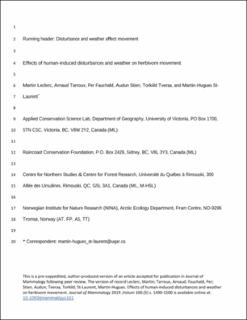| dc.contributor.author | Leclerc, Martin | |
| dc.contributor.author | Tarroux, Arnaud | |
| dc.contributor.author | Fauchald, Per | |
| dc.contributor.author | Stien, Audun | |
| dc.contributor.author | Tveraa, Torkild | |
| dc.contributor.author | St-Laurent, Martin-Hugues | |
| dc.coverage.spatial | Canada | en_US |
| dc.date.accessioned | 2020-03-27T14:32:02Z | |
| dc.date.available | 2020-03-27T14:32:02Z | |
| dc.date.issued | 2019 | |
| dc.identifier.issn | 0022-2372 | |
| dc.identifier.uri | https://hdl.handle.net/11250/2649175 | |
| dc.description.abstract | Human-caused habitat disturbances and climate change are leading threats to biodiversity. Studying the impacts of human activities on wildlife from a behavioral perspective is a relevant starting point to understand the mechanisms underlying population and species resistance and resilience to disturbances. In this study, we assessed the effects of weather (temperature and precipitation), habitat disturbances (roads and clearcuts), and natural habitat types on the space use patterns of a threatened boreal population of woodland caribou (Rangifer tarandus caribou). An extensive data set of 288,665 relocations from 50 adult females outfitted with GPS collars over 7 years in the boreal forest of Québec, Canada was used to evaluate residency time in natural and disturbed habitats for five distinct biologically defined periods. The most parsimonious linear mixed-effects model for each period showed that individuals stayed longer in more natural habitat types. During calving and summer, residency time decreased with increasing road density, whereas residency time decreased with increasing temperature during winter and spring. We found no evidence of a synergistic effect between daily weather and human disturbances on movement behavior of caribou, but consider their respective influence as additive. We also showed large individual variation in residency time, except during the calving period. Lower individual variation in residency time during calving may be explained by strong evolutionary constraints on behavior faced by females to ensure protection and survival of their offspring. Based on our results, we suggest keeping large patches of suitable and roadless habitat for caribou to favor the spacing-out antipredator strategy exhibited by females during calving. By tracking individuals over several complete annual cycles, we showed variation in the effects of daily weather and human disturbances on residency time across biological periods. Our study highlights that the inclusion of daily weather variables helps better understand space-use patterns of a threatened species. | en_US |
| dc.language.iso | eng | en_US |
| dc.subject | boreal forest | en_US |
| dc.subject | climate | en_US |
| dc.subject | first-passage time | en_US |
| dc.subject | GPS-tracking | en_US |
| dc.subject | habitat use | en_US |
| dc.subject | Rangifer tarandus caribou | en_US |
| dc.subject | residency time | en_US |
| dc.subject | ungulate | en_US |
| dc.title | Effects of human-induced disturbances and weather on herbivore movement | en_US |
| dc.type | Journal article | en_US |
| dc.description.version | acceptedVersion | en_US |
| dc.rights.holder | © 2019 American Society of Mammalogists, www.mammalogy.org | en_US |
| dc.subject.nsi | VDP::Matematikk og Naturvitenskap: 400::Zoologiske og botaniske fag: 480 | en_US |
| dc.source.pagenumber | 1490-1500 | en_US |
| dc.source.volume | 100 | en_US |
| dc.source.journal | Journal of Mammalogy | en_US |
| dc.source.issue | 5 | en_US |
| dc.identifier.doi | 10.1093/jmammal/gyz101 | |
| dc.identifier.cristin | 1761863 | |
